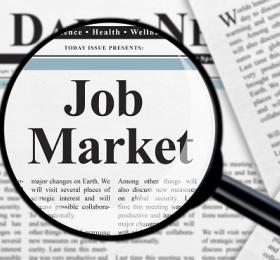
Well, it has been quite a morning. In the early morning hours, news broke that President Donald J. Trump and First Lady Melania have been diagnosed with Covid-19. A few hours later, the Bureau of Labor Statistics released its latest report on the health of the US jobs market, which will be the final reading before the November election.
Nonfarm payrolls in the US increased by 661K in the month of September. Though the headline number indicates that the nascent recovery is still on firm footing, it also underscores some of the cooling that we have seen in recent economic datapoints—more on that to come. September’s official unemployment rate fell to 7.9% from 8.4% and U6 also dropped 1.6% to 12.8%. Meanwhile, labor participation fell 0.3% to 61.4% and wage gains improved marginally by 0.1% MoM. Tepid wage pressures again served as a sort of “heat map” for where the majority of hiring took place last month… payroll expansion skewed toward the lower end of the pay spectrum. Leisure and hospitality lead the way with an additional 318K though the report notes jobs at “food services and drinking places” (i.e. restaurants and bars) remain roughly 2.3M below February levels. Healthy hiring continued in retail and in healthcare with gains of 142K and 108K respectively. Despite a surge in the demand for new homes, construction only added 26K jobs and remains approximately 394K jobs below pre-Covid levels. The data in this month’s report also raise concerns regarding the “stickiness” of unemployment in our Covid world as many temporary layoffs have unfortunately become permanent.
The Fed is on it! Jay Powell reiterated his commitment to low interest rates (and accommodative monetary policy) in statements before the House and Senate this month. He needs some help though and that’s where Congress should step in to assist the Fed in its effort to support the economic recovery. To be sure, certain datapoints reflect that the recovery in some areas of the domestic economy have already returned to pre-pandemic activity levels, but there are others that are flagging. September’s retail sales and personal spending are areas of concern on the consumer front. Softening in core CPI and PPI (relative to August) also indicate a bit more spending could provide a timely boost to the economy. We heard it again, “[The Fed] has lending powers, not spending powers.” Hopefully, Congress will “lend” a hand before the economy forces its hand.
The election is on the horizon and its outcome will likely have a meaningful impact on the US dollar. TWP maintains a bearish view on the greenback relative to other developed market currencies (G-10, trade-weighted basis) as deficit spending and a seemingly unconditional commitment from Fed to support the recovery have become the new normal. Remember when the Powell Fed was raising rates during the trade war? Well, they are “not even thinking about thinking about raising rates” in this environment—at least that makes some sense from a monetary policy perspective. However, the action to watch will be on the fiscal side… stay tuned and STAY HEALTHY!
Market Outlook: Bearish USD, Neutral Duration, Neutral Equities
News Release: Bureau of Labor Statistics (The Employment Situation- September 2020)